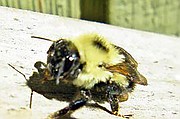Native honeysuckle in two forms benefit ornamental landscaping
I recently received a very welcome phone call from a young man inquiring about honeysuckle and wondering if it is the vine offering the same tubular flowers that he used to nibble from the end for the “honey.”
It made me recall an almost lost memory of doing just that as a youngster, and further, to incorporate it into an informative column readers may enjoy. Honeysuckle (Lonicera) is a hardy area native and I am blessed to have a healthy supply of it – in both of its forms – in my landscape; pictured is a lovely sprawl of vining Lonicera ciliosa on my front yard cedar “pillar.” It is not alone on the property however, because its shrubby “cousin” Twinberry (Lonicera utahensis – holds court on another site conducive to one of its more vital uses. One of the true harbingers of spring (after the Pussywillow { Salix) are the creamy white, yellow stamened double blossoms of Twinberry which, upon blooming, seem to awaken the underground-dwelling bumblebees (Bombus) for their first, much needed sustenance. With binoculars, I watch my two or three shrubs carefully when blossoming begins, and soon, I’ll see one floret pulled down with the weight of a hungry bumblebee – the first of the large insects to arrive (or awaken) in spring.
This past spring I noted that the Twinberry shrubs seemed to be dying out. It alarmed me since bumble and honeybees are disappearing as well. The shrubs – as the vining variety of honeysuckle are natural to the area – and since I use no chemicals of any ilk, I don’t know why this happened. I’ll keep a sharp eye out in May (or whenever the snow’s gone) to check out the status.
A few years back, I was strolling through open woods with an old college friend of mine who had become a forest ranger, enjoying the surroundings and sharing our knowledge of various flora/fauna, when we came upon a small long-dead fir tree with a bottom-to-top spiral “carved” into the trunk. He wondered aloud at what had happened and I – all smarty-pants knowledgeable – said “Lonicera ciliosa honeysuckle.” In all his experience he had never seen, nor been aware of such a thing. In our area it is not so unusual, and probably some of my outdoorsy readers have seen it as well. The creeping vine, looking for height, twines its way up the tree, tightly gripping the bark. Over time, as the tree tries to grow and cannot, it simply dies.
Notwithstanding that one “minus”, the vining honeysuckle is a beautiful addition to any landscape, and Arthur Krukeberg – author of “Gardening with Native Plants of the Pacific Northwest” –agrees and then some. He points out that it won an Award of Merit at a British garden show – and shares the quote of an authority there that “although rare in gardens, it is a fine species and should be more widely cultivated.” Krukeberg, too, recommends that all species should be more widely used either as ornamentals or for wildlife plantings. If, by any chance, you have some on your property, appreciate it and just make sure not to plant your new little saplings close by.
One of the top things in Lonicera’s favor – at my house anyhow, is the constant visits of the whole hummingbird population, plus bevies of butterflies throughout the flowering season – which can be pretty long.
Kate Greenaway’s precious “Language of Flowers” terms the climbing honeysuckle “generous and devoted affection” and the shrub version “Rustic beauty.”
If you ever discover a vine in the wild, look for the root and cut or pull out a small segment – wrapping it in moist paper or moss. At home, tuck it into rich natural soil (no artificial growing solutions!) or water and let it take hold. You may also root cuttings – a little longer wait for rootlets to grow.
Spring-blooming plants as the afore-mentioned Salix or Pussywillow are so rewarding to winter-tired eyes, and a bouquet of the stems of adorable soft, grey catkins are delightful nose-ticklers. I wish I had one but my property is on the dry side, and they prefer moist, even swampy areas.
I am gifted though, with several Serviceberries (Amelanchier alnifolia), which are also fairly early spring bloomers – brightening cool days with lavish white blossoms that light up the neighborhood, followed in early summer by pretty clusters of dusty dark blue berries. Though they are edible they have large seeds and are not really tasty to me, though many folks use them for jelly- but they are ambrosia to the birds! Grosbeaks swarm to them along with many other songbirds, and that’s reason enough to appreciate them.
Covet your native bushes, shrubs and vines – the gift of Nature’s bounty can only be a boon to you and your surroundings. In a later column I’ll enlarge on some of the beautiful and/or beneficial native shrubs that can further augment your landscape.
Valle Novak writes the Country Chef and Weekend Gardener columns for the Daily Bee. She can be reached at bcdailybee@bonnercountydailybee.com. or by phone at 208-265-4688 between the hours of 8 a.m. to 7 p.m.





